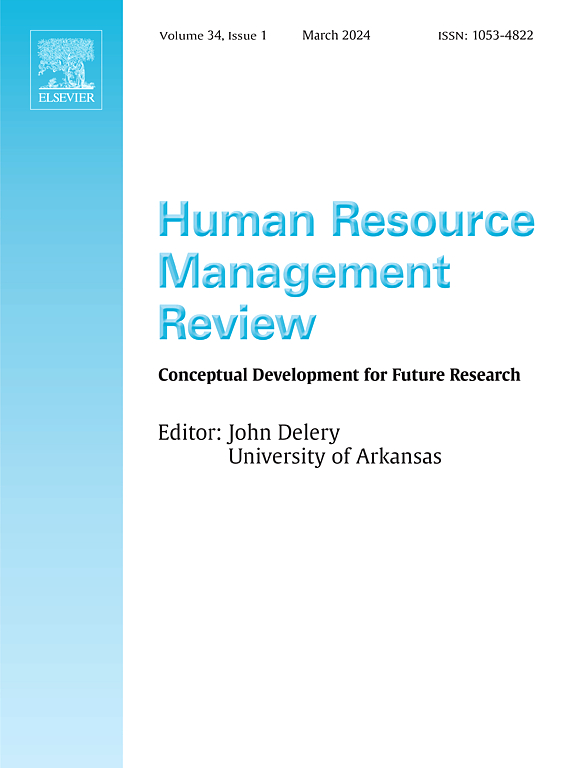工作场所八卦研究的文献计量学系统文献综述
IF 13
1区 管理学
Q1 MANAGEMENT
引用次数: 0
摘要
近年来,学者们对调查职场八卦的动态表现出了极大的兴趣。作为一种复杂且发展迅速的现象,职场八卦引发了一系列研究结果。这种快速增长导致了文献的混乱和碎片化,突出了对全面文献综合的需要。为了解决这个问题,我们采用了文献计量学-系统文献综述(B-SLR)的方法来整合关于工作场所八卦的各种文献。我们系统地检索、选择并严格审查了来自Web of Science和Scopus数据库的258篇研究文章样本。我们的文献计量分析提供了258篇文章的全面概述,然后是183篇文章的批判性文献综合,将之前的研究组织为两个主题:工作场所八卦的前因和结果。这些进一步分为三个子主题:八卦发送者,八卦接收者和八卦目标。此外,我们开发了一个概念框架来说明八卦三位一体之间的相互作用,并提出了基于组织层级的八卦类型学,以及实用的未来研究指南。这项研究为复杂而迅速发展的职场八卦领域带来了清晰和连贯,建立了一个强大的知识库,以指导未来的研究和为政策制定提供信息。本文章由计算机程序翻译,如有差异,请以英文原文为准。
A bibliometric-systematic literature review of workplace gossip research
In recent years, scholars have shown immense interest in investigating the dynamics of workplace gossip. As a complex and rapidly growing phenomenon, workplace gossip has generated a wide range of findings. This rapid growth has led to confusion and fragmentation in the literature, highlighting the need for a comprehensive literature synthesis. To address this, we employed a bibliometric-systematic literature review (B-SLR) approach to integrate the diverse literature on workplace gossip. We systematically searched, selected, and critically reviewed a sample of 258 research articles from the Web of Science and Scopus databases. Our bibliometric analysis provides a thorough overview of 258 articles, followed by a critical literature synthesis of 183 articles, that organized prior studies into two main themes: antecedents and outcomes of workplace gossip. These are further categorized into three sub-themes: gossip sender, gossip receiver, and gossip target. Additionally, we developed a conceptual framework to illustrate the interactions within the gossip triad and proposed a gossip typology based on organizational hierarchical levels, along with practical future research guidelines. This study brings clarity and coherence to the complex and rapidly expanding field of workplace gossip, establishing a robust knowledge base to guide future research and inform policy development.
求助全文
通过发布文献求助,成功后即可免费获取论文全文。
去求助
来源期刊

Human Resource Management Review
MANAGEMENT-
CiteScore
20.20
自引率
7.00%
发文量
0
审稿时长
48 days
期刊介绍:
The Human Resource Management Review (HRMR) is a quarterly academic journal dedicated to publishing scholarly conceptual and theoretical articles in the field of human resource management and related disciplines such as industrial/organizational psychology, human capital, labor relations, and organizational behavior. HRMR encourages manuscripts that address micro-, macro-, or multi-level phenomena concerning the function and processes of human resource management. The journal publishes articles that offer fresh insights to inspire future theory development and empirical research. Critical evaluations of existing concepts, theories, models, and frameworks are also encouraged, as well as quantitative meta-analytical reviews that contribute to conceptual and theoretical understanding.
Subject areas appropriate for HRMR include (but are not limited to) Strategic Human Resource Management, International Human Resource Management, the nature and role of the human resource function in organizations, any specific Human Resource function or activity (e.g., Job Analysis, Job Design, Workforce Planning, Recruitment, Selection and Placement, Performance and Talent Management, Reward Systems, Training, Development, Careers, Safety and Health, Diversity, Fairness, Discrimination, Employment Law, Employee Relations, Labor Relations, Workforce Metrics, HR Analytics, HRM and Technology, Social issues and HRM, Separation and Retention), topics that influence or are influenced by human resource management activities (e.g., Climate, Culture, Change, Leadership and Power, Groups and Teams, Employee Attitudes and Behavior, Individual, team, and/or Organizational Performance), and HRM Research Methods.
 求助内容:
求助内容: 应助结果提醒方式:
应助结果提醒方式:


